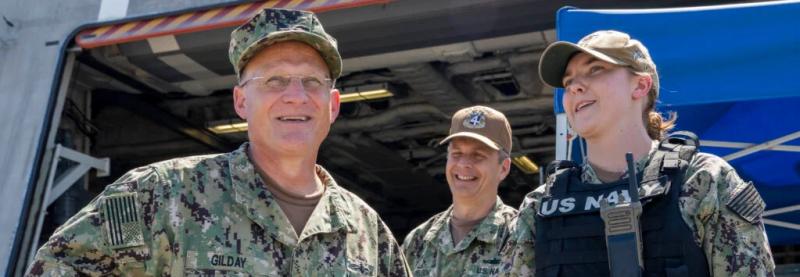
Chief of Naval Operations Adm. Mike Gilday aboard the littoral combat ship USS Detroit
In January of this year, while speaking before the annual Surface Navy Association symposium, US Chief of Naval Operations Adm. Mike Gilday was blunt. He said, “I don’t mean to be dramatic, but I feel like if the Navy loses its head, if we go off course and we take our eyes off those things we need to focus on, I think we may not be able to recover in this century.”
Now, as the Biden administration readies a Navy budget proposal this week to send to lawmakers. Adm. Gilday insists that the Navy is on a “positive trajectory” but that it will have to rebuild confidence under congressional scrutiny as it prepares a new strategic plan that’ll include another long-term investment: unmanned vehicles.
The problems faced by the Navy are numerous.
As David Sharp writing in the Associated Press points out, the Navy’s speedy littoral combat ships had propulsion failures. The gun on its stealthy destroyer, USS Zumwalt, is a dud because of expensive ammo. Its newest aircraft carrier, USS Gerald Ford, has problems with the system that launches aircraft and with its weapons elevators, among other systems.
On top of that, embarrassing photos of rusty ships online have underscored delays in maintaining warships, made worse by the pandemic.
The Navy’s troubles have caused delays and cost billions of dollars. They come as tensions are growing in the South China Sea, Russia’s navy is emboldened, Iranian speedboats are harassing vessels in the Persian Gulf.
“Are we ready to meet the threat from China? No,” said Loren Thompson, a defense analyst at the Lexington Institute.
“It tried too hard to leap ahead technologically at the beginning of the last decade,” Thompson said. “As a result, every vessel that it started had severe problems.”
The challenges are not limited to hardware and ships. Operating tempo and crew training are also major issues.
Sharp goes on to note that lawmakers have scrutinized the Navy’s readiness and overextended crews since 17 sailors were killed in two separate collisions involving Navy destroyers in 2017. Technology failure and human error factored into both collisions.
The Navy’s unceasing tempo continues to cause stress on ships and crew. Photos of the USS Stout, an Arleigh Burke-class destroyer, showed plentiful rust as it returned from a 210-day deployment last fall to Norfolk Naval Station in Virginia. The rust was cosmetic but underscored the toll of deferred maintenance and long deployments on ships and sailors, who made no port calls during the pandemic.
“It’s wearing out the Navy, the crews, their personnel, their families,” said Matt Caris, a defense analyst at Avascent, a consulting firm in Washington, who said investments are needed in sailors, maintenance and new ships.
Nevertheless, Admiral Gilday sees a path forward. “I’m not saying that we’re satisfied with where we are,” he said. “What I will say is that I think that certainly the trends are headed in the right direction.”
Thanks to Alan Rice for contributing to this post.

See – American military chief hails HMS Queen Elizabeth ‘the best ship he has ever been on’
ENVIOUS American top brass have admitted the Royal Navy’s flagship HMS Queen Elizabeth is one of the world’s ‘nicest ships to serve on’.
Colonel Simon Doran, the senior American officer on board the aircraft carrier, said his team of about 250 US personnel were loving life on board the £3.2bn warship.
See: https://www.portsmouth.co.uk/news/defence/american-military-chief-hails-hms-queen-elizabeth-the-best-ship-he-has-ever-been-on-3246908?fbclid=IwAR1CjYkiqJuTwT6gpbV9qw6c-wKhbUohKrNEEQmv1FzRaAqV77cozPbYNBg